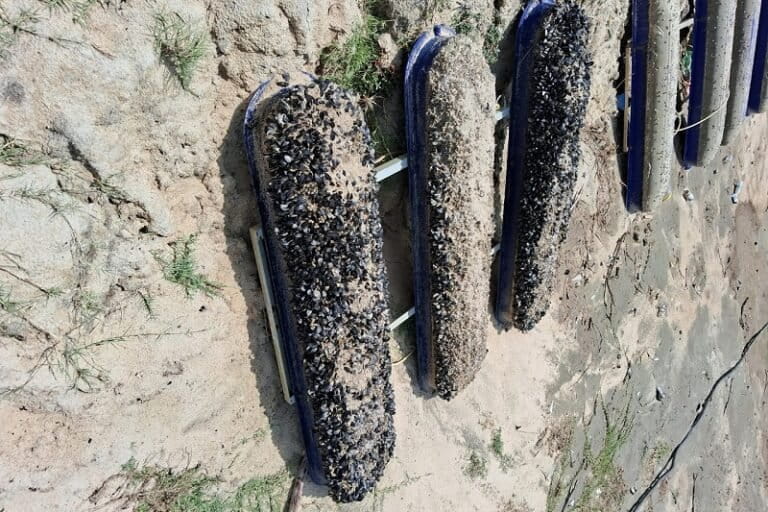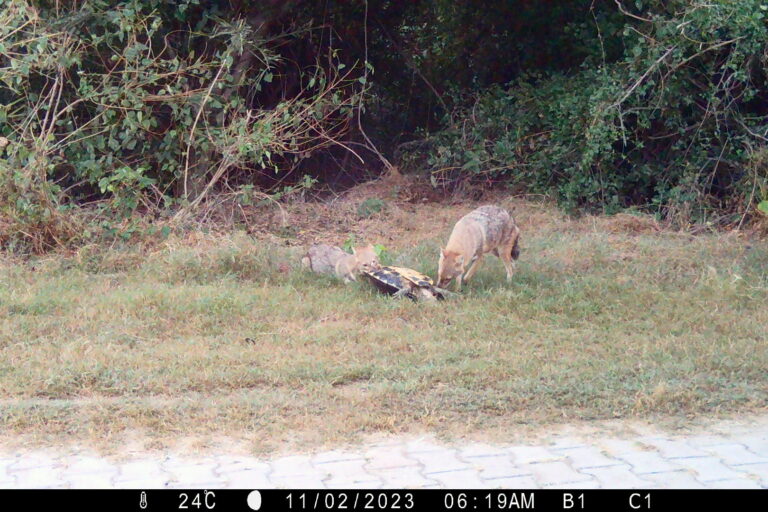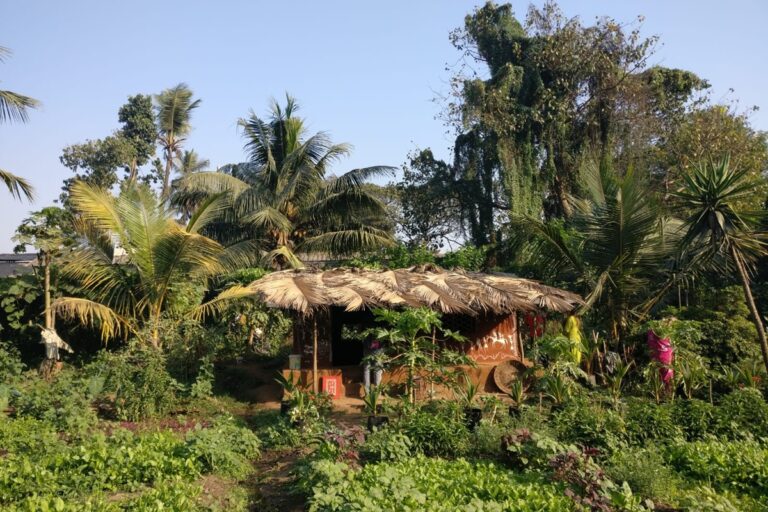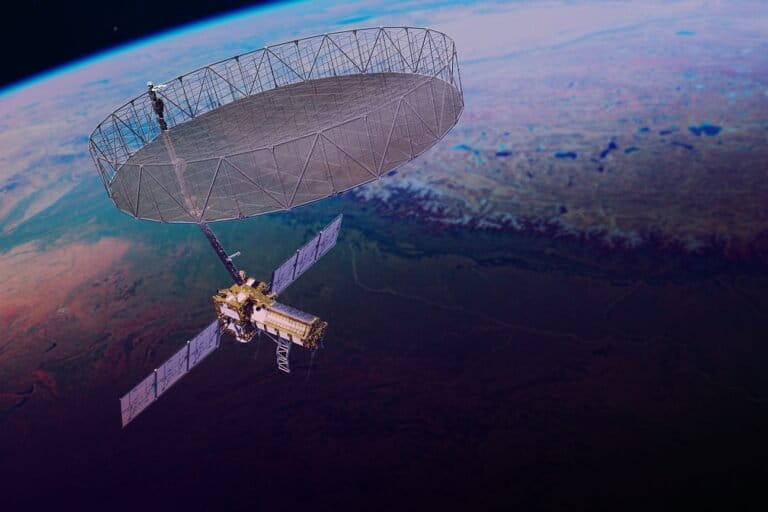- A study shows 17 marine species attached to plastic bottles and other items on the coast of Tamil Nadu, raising concerns about potential ecosystem impacts.
- The species included the invasive, tropical American brackish water mussel that is found to affect fishing in Kerala backwaters.
- Rafting on marine litter and transported through ships worldwide, invasive organisms can affect local biodiversity and ecosystems, scientists say.
Marine organisms take piggyback rides on plastic, rubber, glass, foam sponge, metal and wood debris to reach the shores of southeastern India, raising concerns about local biodiversity conservation, a new study has reported.
The invasive, tropical American brackish water mussel Mytella strigata found to affect fishing in Kerala backwaters is one of the species found rafting on the debris, report Gunasekaran Kannan and team at the Centre for Aquaculture at Sathyabama Institute of Science and Technology, Chennai, in the study published in September 2023 in the Marine Pollution Bulletin.
The study calls attention to twin problems – marine pollution and invasive species. “Marine debris…is disposed (of), discarded or abandoned in coastal and marine environments or brought indirectly to the sea by inland waterways and winds.”
The study on the Bay of Bengal coast, from Puducherry to Parangipettai in Tamil Nadu, found 17 ‘encrusting’ species that stick on surrounding surfaces. These species belong to seven large categories of animals called phyla – arthropods, moss animals, study, annelids, cnidarians, chlorophyta and foraminiferans.
About 400 non-native species of mussels, barnacles, sponges, sea squirts and bristle worms raft on marine litter worldwide and often push out local organisms, the study pointed out.
Polluted beaches
The study documents the lesser studied marine litter as a carrier for species dispersal in India, one of the world’s largest producers and consumers of plastics.
“I used to go to the beaches of Puducherry and Parangipettai in search of samples,” said Kannan. “I found barnacles and algae attached on water bottles, ropes, nets, bags and clothes — 18 different types of items — all over the intertidal space (the area where the ocean meets the land between high and low tides).” Back then, he was a scientist at the Centre of Advanced Study in Marine Biology, Annamalai University, Cuddalore.
“I found bottles from Myanmar, Bangladesh and Indonesia – plastic energy drinks bottles and two sprayers used in salons. Probably they came from ships or directly from the shores of those countries.” After the northeastern monsoon, when the Bay of Bengal turns very rough with strong wind, waves and currents, a lot of debris is seen spread over the beaches of Tamil Nadu, Kannan said.

The study was conducted at eight sites between Puducherry and Parangipettai which comprised four urban sites – Puducherry, Silver Beach, Samiyarpettai and Puthupettai. The remaining four sites were small villages with limited fishing activity.
The team collected 3130 specimens/colonies attached to 20 types of marine litter, mostly plastic fragments, bottle caps, lids, bottles, jars and food containers. The urban sites reported more litter and plastics carried more organisms compared to other materials.
The organisms that led the list of the rafters of litter were Jellyella tuberculata and Jellyella eburnea – two moss animals or bryozoans that live in colonies and build outer protective structures like those of corals. The list also includes three species of barnacles – Lepas anserifera (goose barnacle), Amphibalanus amphitrite (striped acorn barnacle) and another Amphibalanus species – which are sticky little crustaceans related to shrimps and lobsters. Additionally, Saccostrea cucullata (rock oyster) and Magallana bilineata (black scar oyster) oyster species were among the top litter-riding organisms.
The most common moss animals found on the litter have been found around the world, suggesting that they can originate and move anywhere, as the scientists pointed out. American mussel might have travelled on litter too, they speculate on the basis of their findings. The study highlights littering of the Indian shores with a risk of bio-invasion, and calls attention to the origins of litter as well as suggests control mechanisms.
Spreading litter
Annually, an estimated 4.8-12.7 million tonnes of marine litter enter into marine habitats globally, and often travel long distances. A famous example is that of debris from the 2011 Tōhoku earthquake and tsunami reaching the coasts of Oregon and Washington, USA, carrying algae across the Pacific.
“Once debris enters the sea, it either floats or sinks and can be transported to other areas by currents, washing up onto the shoreline and beaches, or drifting offshore and sinking to the deepest ocean trench,” Kannan and colleagues wrote in the study. “Marine litter also causes major threats to marine biota, for instance, through ingestion and entanglement of marine megafauna, such as sharks, fish, turtles, dolphins, and seabirds, among others.”
In the marine environment, alien species introduced outside their natural range can cause ecological changes such as the loss of native genetic characteristics, habitat degradation, changes in feeding patterns, and displacement of native species, studies show.
Shipped worldwide
Recent research by British scientists has traced the global movements of all ships entering the Antarctic waters, as a potential source of non-native species, including mussels, barnacles, crabs and algae, from almost anywhere across the globe, threatening isolated native species.
Sailors say many organisms such as barnacles attach themselves to ships’ hulls, in a process termed ‘biofouling’ and make sailing difficult. “We have to remove them regularly at dry docks, or they will affect the ship’s speed,” said Roy Pereira, a former international sailor based in Kannur, India. “To keep barnacles away, we often use antifouling paint, but still they come.”

Reportedly, anti-fouling paint that kills barnacle larvae also kills other marine organisms. As scientists have found, covering surfaces with silicone-based ‘barnacle cement’ structures shaped like mushrooms can prevent fouling organisms from getting a foothold on the ship’s hull.
Ballast water discharge could be another way of introducing non-native species. “We take ballast water on board for stability when there is not enough load. It can carry organisms across the globe,” Pereira said. Untreated ballast water released at the ship’s destination could potentially introduce a new invasive marine species and ships need to manage it under an international treaty.
Invasive species
An example of an invasive species that has possibly travelled in the ballast water is Mytella strigata or the American brackish water mussel. Scientists reported that they were found abundantly on “floating plastic bottles, wooden pilings, walls of fish cages, hulls of boats and bottom sediment” in the backwaters near Kochi in the summer of 2019. “The invasion of this species in Cochin (Kochi) may be through ballast water or fouling on ships’ hulls from its native range or from Singapore where it has been established recently,” marine biologist P. R. Jayachandran and colleagues wrote in Bioinvasions Records. Their samples came from the waters near the port where there were “oil tankers, cargo vessels, huge freight ships, passenger vessels…”
“There are also chances that they came through marine debris,” Jayachandran, a marine biologist at the Applied Research Center for Environment and Marine Studies at King Fahd University of Petroleum & Minerals, Saudi Arabia, told Mongabay India. The local fishers initially thought they were the native green mussel (Perna virdis), and started eating them, but they realised from the taste that it is not,” he added. It is not as tasty.
The American mussels were found attached in high densities to floating plastic bottles, wooden pilings, walls of fish cages, hulls of boats and bottom sediment. They dominated all habitats, including the bottom, intertidal space, concrete structures, plastic debris, Jayachandran said. “They have become widespread in the Indo-Pacific region, with densities reaching 40,800 per square metre, a potential threat to the lucrative Asian green mussel aquaculture.”
Known to grow fast, mature early, tolerate salinity better, the American mussels compete with the wild spats (very young) of the locally abundant mussels across estuaries and backwaters systems in Kerala, new reports show.
There is concern in coastal villages of south India about marine species changes too. “There are invasive barnacles, amphipods and crabs,” said Kumar Sahayaraju, an artisan fisherman pursuing doctoral research in marine biology and indigenous knowledge at Transdisciplinary University, Bengaluru. “Some fish are disappearing. They include flounders, soles, squirrel fish, ponyfish, trevally…”
Such ecosystem changes can be irreversible and potentially damaging to biodiversity and livelihoods. Sahayaraju suggested detailed studies and conservation measures.
Meanwhile, reports of debris in the “pristine waters and clean beaches” of places such as the Nicobar archipelago have prompted scientists to call for effective strategies to control the menace of marine plastic pollution.
Banner image: Barnacles on a plastic bottle found on the beach. About 400 non-native species of mussels, barnacles, sponges, sea squirts and bristle worms raft on marine litter worldwide and often push out local organisms. Photo by Gunasekaran Kannan.














